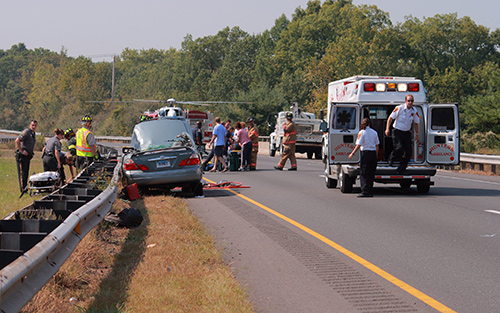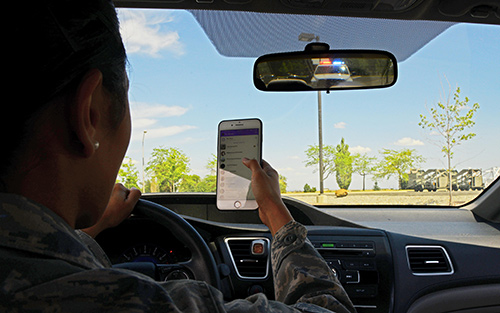
Here’s How to Stop Distracted Driving
How many times have you been stuck behind someone when the light turns green, but they’re too busy texting to notice? Have you ever had someone drift out of their lane and nearly sideswipe you? Those are both signs of distracted driving. And when it happens to someone who’s driving on the clock, it’s only a matter of time before it costs their employer.
Most of us have close brushes with distracted drivers every day. But this bad habit is more than a minor annoyance: According to the National Highway Traffic Safety Administration, distracted driving claimed 3,142 lives in 2019. More than 400,000 others were injured in crashes related to distracted drivers. Some of these people likely worked for organizations like yours that rely on vehicles to generate revenue. You can imagine the impact these accidents have on these businesses.
The problem is costly enough that governments are trying to figure out how to stop distracted driving. A “hands-free” driving law in Florida went into effect on the same week a truck driver was arrested on suspicion of causing a fatal crash while his focus wasn’t on the road in front of him. But there are some measures you and your organization can take to proactively help without laws or regulations.
First Off, What is Distracted Driving?
Anything that takes your attention from driving counts. That’s using your cell phone, taking a sip from your Big Gulp, lighting a cigarette, or even just trying to find some good music on the radio.
The NHTSA outlines three major types of distractions: visual (taking your eyes off the road), manual (taking your hands off the wheel), and cognitive (taking your mind off what you’re doing). Since every crash is a unique set of circumstances, it’s difficult to say which type of distraction is the riskiest even though we’re quick to blame smartphones.
Still, there are some concrete actions you can take to stop distracted driving – and they apply to organizations as well as individuals.
Think About How to Use Your Phone
Leaving your phone alone while driving is one of the best ways to stop distracted driving. For commercial drivers, it’s probably easier to ignore personal calls and messages. It’s the ones from customers or the office that are a challenge.
At some point, commercial drivers will get pinged by a dispatcher or supervisor. Having a co-worker handle that communication is a great policy, but it’s not always possible. So how do you reconcile telling employees not to use phones while they rely on them for instructions from the office? And what do you do when your city or state has laws against it?
If your area still allows cell phone use while driving, your solution could be to ask drivers to set up ring tones for work numbers. That way, they’re at least answering fewer calls. You could also provide company-issued phones.
And if you can’t use cell phones according to your local laws? Pull over before taking a call. It’s that simple.
Eating/Drinking While Driving: Riskier Than We Realize
It’s tempting to save time by cruising into a drive-through and eating on the go. Eight out of 10 drivers admit that they eat or drink while driving. While it’s a common behavior, it’s also riskier than we realize. The NHTSA found that eating or drinking increases the likelihood of near misses or crashes by 39%.
It’s smart for organizations to consider policies that ban eating and drinking behind the wheel. Even if your organization doesn’t have a policy, you can be a safer driver by choosing to do all your eating and drinking while parked. Bonus: Your vehicle will be cleaner without all the spills and crumbs!
Resist the Urge to Rubberneck
It’s strange how one traffic accident can cause others – or at least spawn quite a few near misses. You’d think an accident scene would encourage better driving, at least temporarily. Instead, a National Safety Council survey found that 80% of drivers slow down for a closer look at the scene.
And 71% of drivers admitted not only to looking at emergency scenes, but taking photos of them. They’re taking their eyes off the road and their hands off the wheel.
It’s also important to remember that driving distracted near accidents can put first responders at risk: At least 16 responders have died this year from crashes related to distracted drivers.
As an organization, you can provide guidelines for your drivers to avoid slowing down near accident scenes. And individual drivers can stop distracted driving by keeping their eyes on the road and hands off the phone.
Cut Out Multitasking
It’s easy to understand why people think multitasking is a good thing. Who doesn’t like to get more done in less time?
Still, people can only process so much information at one time. That’s why driving while solving a work crisis, talking on the phone, finding your favorite song on the radio, and navigating to your next destination might not be the best idea.
A formal policy can help organizations. Outline what behaviors are included. Discuss the risks of these behaviors. And set an expectation for how employees are expected to help stop them from driving distracted.

Know and Follow the Laws
Texting while driving is banned in 48 states, and many states and municipalities have laws about cell phone use. Still, these laws are only effective if the drivers follow them. It’s also possible for drivers to get away with using devices because some laws only allow drivers to be cited for texting or cell phone use as a secondary offense: In other words, you have to be pulled over for a different violation. This varies by jurisdiction (Pro Tip: Instead of trying to figure out your current jurisdiction’s laws, err on the safe side and leave the phone alone while driving).
The recent Florida law is an exception. Police can cite drivers for using devices as a primary offense.
Amazingly, at least one proposed law was met with strong opposition from legislators.
Stay Awake, Stay Alive
More than one-third of drivers surveyed by the National Sleep Foundation admitted that they’ve fallen asleep while driving. The NHTSA found that drowsy driving caused 72,000 crashes in 2013.
What’s making people nod off while driving? Fatigue is the biggest factor, along with untreated sleep disorders, medication, and alcohol. The Center for Disease Control also found that commercial drivers and shift workers are likely to drive drowsy.
It’s just not feasible for organizations to mandate their employees’ sleep habits. But you can encourage employees to either switch drivers (if there’s more than one) or pull over for a rest if they exhibit signs of drowsy driving.
You can learn more about the causes and consequences of drowsy driving at the DrowsyDriving.org, the website for Drowsy Driving Prevention Week.

See Bad Habits with a Fleet Dash Camera
All of these suggestions depend on trusting your drivers. But let’s be realistic: It will be hard to hold them accountable by just hoping they adhere to these suggestions. You have no idea what’s happening inside a vehicle once it leaves the yard.
That’s where a fleet dash camera can help. With multiple cameras facing outward, your fleet manager can spot signs of driving distracted. For example, a driver who frequently drifts out of their lane or hits rumble strips could easily by driving while tired, using a cell phone, or eating behind the wheel.
You can also use driver-facing cameras to stop drowsy driving. Some AI-equipped models can spot signs like frequent yawning and blinking. Fleet managers can also get warnings about these habits, which can stop an accident before it happens. The inward-facing view can also be a deterrent to cell phone use and other distracted driving behavior.
Of course, the biggest benefit of AI-equipped cameras is that they can support your drivers if there’s an accident. They can prove that your drivers were alert and focused or not at fault. And deploying them in your fleet is also a sign of your organization’s commitment to safety.





